Case Studies
Too much corporate wear ends up in landfill in the UK because of the barriers to other, more sustainable, end-of-life options for this type of clothing.
Uniform design, branding (applied for taxation purposes), fabric choice, construction methods and collection infrastructure all contribute to making sustainable end-of-life options difficult and costly.
Nevertheless, Uniform Reuse has worked with companies from all along the textiles supply chain to find a better way to dispose of end-of-life corporate wear. Some of our case studies from fabric and garment manufacturers, corporate wear purchasers and organisations accepting end-of-life textiles are given here:
Case Studies — Manufacturers
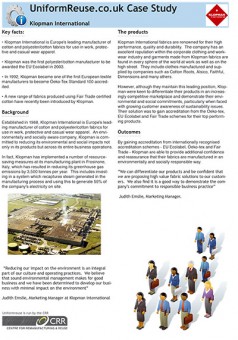
Klopman International
Klopman International is the first polyester/cotton manufacturer to be awarded the EU Ecolabel, and now provides corporate clothing manufacturers with sustainably sourced fabrics, including Fairtrade cotton.
Download pdf (1644kB)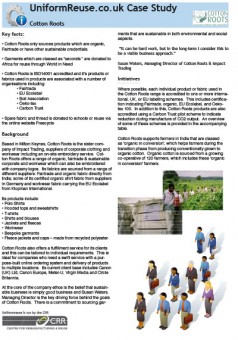
Cotton Roots
As a corporate clothing manufacturer, Cotton Roots sources all its material from sustainable origins. All ‘seconds’ are immediately sent for reuse, often in Asia and Africa, and any left over thread and fabric is sent for use in schools, or donated for reuse elsewhere.
Download pdf (1774kB)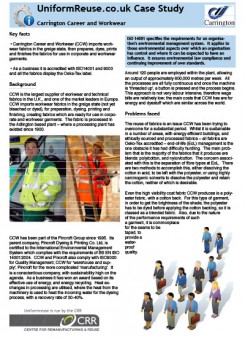
Carrington Career and Workwear (CCW)
Whilst EoL still remains an issue, Carrington is focussed on overcoming this, and has implemented strategies to extend the life of garments until the issue can be resolved. Sustainable manufacturing and management are paramount, with accreditation to ISO 14001 and 9000
Download pdf (1027kB)
Case Studies — Purchasers
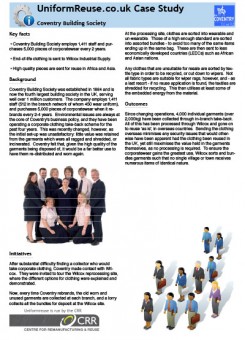
Coventry Building Society
Not satisfied with garments going to recovery for shredding and incineration, Coventry actively seeks the optimum EoL system for its garments, and now clothing is sent overseas for direct reuse, with only unwearable garments being shredded for recycling
Download pdf (967kB)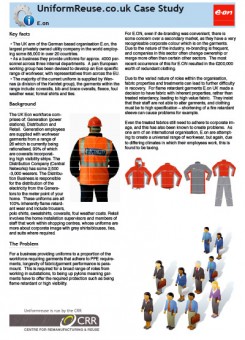
E.on
For a business providing uniforms to a proportion of the workforce requiring garments that adhere to PPE requirements, longevity of fabric/garment performance is paramoun
Download pdf (1313kB)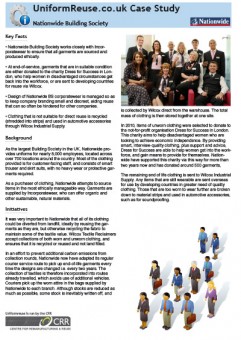
Nationwide Building Society
Nationwide attempts to source as much of its corporate clothing as possible from sustainable materials. EoL garments are utilised in the optimum way, with local reuse if possible, overseas if not, and only the very minimum of fabric going to recycling where no other option is available. No material is sent directly to landfill
Download pdf (1230kB)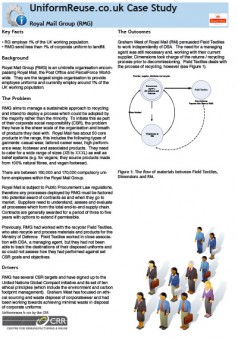
Royal Mail Group (RMG)
Employing over 1% of the UK workforce, the Royal Mail Group generates significant volumes of corporate clothing, yet still sends less than 1% to landfill. This is largely accomplished by ensuring traceability at end-of-life, and through the use of a distinctive bar code incorporated into garments, allowing ease of sorting
Download pdf (1160kB)
Case Studies — Reprocessors
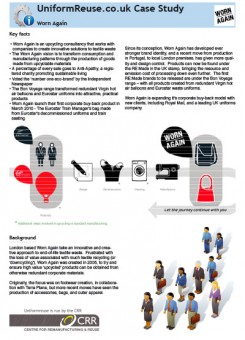
Worn Again
Worn Again is an upcycling consultancy that works with companies to create innovative solutions to textile waste
Download pdf (1831kB)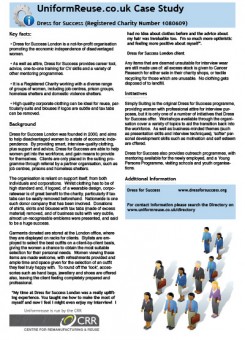
Dress for Success
Dress for Success is a not-for-profit organisation, promoting the economic independence of disadvantaged women. It accepts high quality corporatewear for women to use as interview outfits, in order for them to gain employment.
Download pdf (665kB)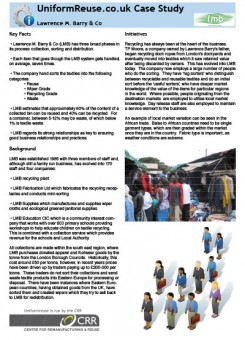
LMB
Only around 1% of the textiles LMB receives ends up in landfill. By employing specialised ‘sorters’, garments are separated into three grades, with clothing first sent for reuse as is; then reuse for lower value outputs; and finally recycling of fabric alone as a final option.
Download pdf (1280kB)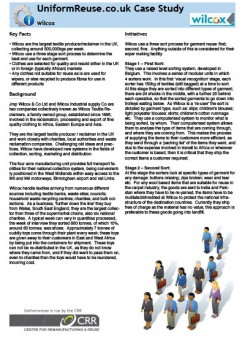
Wilcox
Wilcox are one of the largest textile reclamation companies in the UK and collect clothing from a huge range of sources, including charities, supermarkets, household waste recycling centres and local authorities. Corporate clothing is reused where possible, but as a last option, all fabric is utilized in a recycling process for other end uses.
Download pdf (1342kB)


